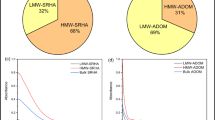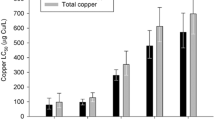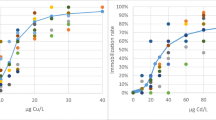Abstract
The increased copper ion (Cu2+) concentrations in aquatic ecosystem significantly influence the environmental quality and ecosystem safety, while information on the Cu2+ biotoxicity to aquatic microorganisms and the models for biotoxicity prediction are still unclear. In this study, the toxicities of Cu2+ to Chlorella vulgaris under different environmental conditions (e.g., Na+, K+, Ca2+, Mg2+, pH, and dissolved organic matter) were explored, with the experimental results in comparison with those predicted by the biotic ligand model (BLM). Results showed that increased Cu2+ concentration caused obvious toxicities to C. vulgaris, whereas the commonly occurring cations and dissolved organic matters can protect the metabolism system of C. vulgaris. The presence of extracellular polymeric substances (EPS) matrix can alleviate the biotoxicity via increasing the surface biosorption but decreasing cell internalization of Cu2+ in C. vulgaris. Due to the presence of EPS matrix, the experimental biotoxicity results under each condition were significantly lower than those predicted by the BLM model, which was thus modified via taking the EPS matrix as the supplement of allochthonous organic matters. After that, the modified BLM was characterized with a higher degree of precision and can be used in natural waters for biotoxicity prediction. Results obtained can enhance our insights into the ecological effects and biotoxicity prediction of heavy metals in natural aquatic ecosystems.






Similar content being viewed by others
References
Bai H, Wei S, Jiang Z et al (2019) Pb (II) bioavailability to algae (Chlorella pyrenoidosa) in relation to its complexation with humic acids of different molecular weight. Ecotoxicol Environ Saf 167:1–9
Chen L, Wang Y, Shi L et al (2019) Identification of allelochemicals from pomegranate peel and their effects on Microcystis aeruginosa growth. Environ Sci Pollut Res 26:22389–22399
Cheng Q, Jiang Y, Jin Z et al (2020) Enhanced excretion of extracellular polymeric substances associated with nonylphenol tolerance in Dictyosphaerium sp. J Hazard Mater 395:122644
Ciera MK, Kyla JI, Maas H et al (2017) Cell density dependence of Microcystis aeruginosa responses to copper algaecide concentrations: implications for microcystin-LR release. Ecotoxicol Environ Saf 145:591–596
Clifford M, McGeer JC (2010) Development of a biotic ligand model to predict the acute toxicity of cadmium to Daphnia pulex. Aquat Toxicol 98:1–7
Cremazy A, Wood CM, Ng TY et al (2017) Experimentally derived acute and chronic copper biotic ligand models for rainbow trout. Aquat Toxicol 192:224–240
De Schamphelaere KAC, Janssen CR (2006) Bioavailability models for predicting copper toxicity to freshwater green microalgae as a function of water chemistry. Environ Sci Technol 40:4514–4522
De Schamphelaere KAC, Nys C, Janssen CR (2014) Toxicity of lead (Pb) to freshwater green algae: development and validation of a bioavailability model and inter-species sensitivity comparison. Aquat Toxicol 155:348–359
Gao Y, Feng J, Han F et al (2016) Application of biotic ligand and toxicokinetic-toxicodynamic modeling to predict the accumulation and toxicity of metal mixtures to zebrafish larvae. Environ Pollut 213:16–29
Gao Y, Feng J, Zhu J et al (2020) Predicting copper toxicity in zebrafish larvae under complex water chemistry conditions by using a toxicokinetic-toxicodynamic model. J Hazard Mater 400:123205
Gu S, Lan C (2021) Biosorption of heavy metal ions by green alga Neochloris oleoabundans: effects of metal ion properties and cell wall structure. J Hazard Mater 418:126336
He Z, Liu W, Wang L et al (2016) Role of extracellular polymeric substances in enhancement of phosphorus release from waste activated sludge by rhamnolipid addition. Bioresour Technol 202:59–66
Huang D, Xu B, Wu J et al (2019) Adsorption and desorption of phenanthrene by magnetic graphene nanomaterials from water: roles of pH, heavy metal ions and natural organic matter. Chem Eng J 368:390–399
Ivey CD, Besser JM, Steevens JA et al (2019) Influence of dissolved organic carbon on the acute toxicity of copper and zinc to white sturgeon (Acipenser transmontanus) and a cladoceran (Ceriodaphnia dubia). Environ Toxicol Chem 38:2682–2687
Lekshmi R, Rejinie M, Sathya R et al (2022) Adsorption of heavy metals from the aqueous solution using activated biomass from Ulva flexuosa. Chemosphere 306:135479–135479
Mangal V, Stenzler A, Poulain G et al (2019) Aerobic and anaerobic bacterial mercury uptake is driven by algal organic matter composition and molecular weight. Environ Sci Technol 53:157–165
Maryam R, Sanza B (2018) An Eco-friendly approach for copper(II) biosorption on alga Cystoseira indica and its characterization. Environ Prog Sustain 38:1–8
Mu Y, Wang Z, Wu F et al (2018) Model for predicting toxicities of metals and metalloids in coastal marine environments worldwide. Environ Sci Technol 52:4199–4206
Nys C, Janssen CR, Mager EM et al (2014) Development and validation of a biotic ligand model for predicting chronic toxicity of lead to Ceriodaphnia dubia. Environ Toxicol Chem 33:394–403
Pagliaccia B, Carretti E, Severi M et al (2021) Heavy metal biosorption by extracellular polymeric substances (EPS) recovered from anammox granular sludge. J Hazard Mater 424:126661
Park J, Ra J, Rho H et al (2018) Validation of a biotic ligand model on site-specific copper toxicity to Daphnia magna in the Yeongsan River, Korea. Ecotox Environ Safe 149:108–115
Qu R, Wang X, Liu Z et al (2013) Development of a model to predict the effect of water chemistry on the acute toxicity of cadmium to Photobacterium phosphoreum. J Hazard Mater 262:288–296
Sanchez-Marin P, Santos-Echeandia J, Nieto-Cid M et al (2010) Effect of dissolved organic matter (DOM) of contrasting origins on Cu and Pb speciation and toxicity to Paracentrotus lividus larvae. Aquat Toxicol 96:90–102
Sánchez-Marín P, Slaveykova VI, Beiras R (2010) Cu and Pb accumulation by the marine diatom Thalassiosira weissflogii in the presence of humic acids. Environ Chem 7:309–317
Shen L, Li Z, Wang J et al (2018) Characterization of extracellular polysaccharide/protein contents during the adsorption of Cd(II) by Synechocystis sp. PCC6803. Environ Sci Pollut Res 25:20713–20722
Shi Z, Du H, Wang C et al (2022) Quantifying the bioaccumulation of Pb to Chlorella vulgaris in the presence of dissolved organic matters with different molecular weights. Environ Sci Pollut Res 29:70921–70932
Slaveykova VI, Wilkinson KJ, Ceresa A et al (2003) Role of fulvic acid on lead bioaccumulation by Chlorella kesslerii. Environ Sci Technol 37:1114–1121
Wang W, Liang Q, Zhao J et al (2016) Application of biotic ligand model in predicting copper acute toxicity to Carp (Cyprinidae). Bull Environ Contam Toxicol 98:22–26
Worms Isabelle AM, Wilkinson KJ (2007) Ni uptake by a green alga. 1. Validation of equilibrium models for competition effects. Environ Sci Technol 41:4264–4270
Xie Q, Liu N, Lin D et al (2020) The complexation with proteins in extracellular polymeric substances alleviates the toxicity of Cd (II) to Chlorella vulgaris. Environ Pollut 263:114102
Xu H, Lv H, Liu X et al (2016) Electrolyte cations binding with extracellular polymeric substances enhanced Microcystis aggregation: implication for Microcystis bloom formation in eutrophic freshwater lakes. Environ Sci Technol 50:9034–9043
Zhao J, Liu S, Liu N et al (2019) Accelerated productions and physicochemical characterizations of different extracellular polymeric substances from Chlorella vulgaris with nano-ZnO. Sci Total Environ 658:582–589
Zhao G, Hong Y, Li L et al (2022) Selection and characterization of plant-derived alkaloids with strong antialgal inhibition: growth inhibition selectivity and inhibitory mechanism. Harmful Algae 117:102272
Zhou K, Hu Y, Zhang L et al (2016) The role of exopolymeric substances in the bioaccumulation and toxicity of Ag nanoparticles to algae. Sci Rep 6:32998
Funding
This study was supported partially by the National Natural Science Foundation of China (52250093, 51979265, 42161022), Jiangxi Science and Technology Innovation Base Plan (20212bcd42014), and Jiangxi Provincial Natural Science Foundation (20212BAB213041).
Author information
Authors and Affiliations
Contributions
Ming Kong: investigation, data curation, writing original draft. Zhiqiang Shi: formal analysis, validation, writing original draft. Fei Liu: investigation, visualization. Na Song: conceptualization, validation. Lizhen Liu: conceptualization, formal analysis. Rongfu Li: formal analysis. Yongming Wu: conceptualization, validation. Huacheng Xu: conceptualization, validation, writing — review and editing, funding acquisition.
Corresponding author
Ethics declarations
Ethics approval
There are no human or animal subjects in this manuscript, and the ethical approval is thus not provided.
Consent to participate
Written informed consent was obtained from all the authors for the publication of this study.
Consent for publication
The publication of this manuscript had been approved by all authors.
Competing interests
The authors declare no competing interests.
Additional information
Responsible Editor: Marcus Schulz
Publisher’s note
Springer Nature remains neutral with regard to jurisdictional claims in published maps and institutional affiliations.
Supplementary information
ESM 1
(DOCX 397 kb)
Rights and permissions
Springer Nature or its licensor (e.g. a society or other partner) holds exclusive rights to this article under a publishing agreement with the author(s) or other rightsholder(s); author self-archiving of the accepted manuscript version of this article is solely governed by the terms of such publishing agreement and applicable law.
About this article
Cite this article
Kong, M., Shi, Z., Liu, F. et al. Investigation and prediction of the biotoxicity of Cu2+ to Chlorella vulgaris: modification of the biotic ligand model. Environ Sci Pollut Res 30, 110612–110622 (2023). https://doi.org/10.1007/s11356-023-30165-9
Received:
Accepted:
Published:
Issue Date:
DOI: https://doi.org/10.1007/s11356-023-30165-9




